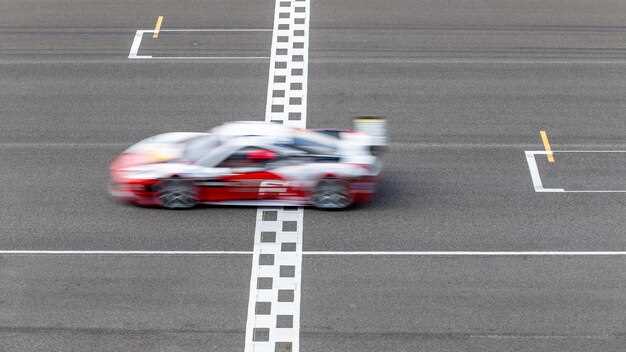
In the world of GT racing, the significance of a powerful launch cannot be overstated. The initial start of a race sets the tone for the entire performance of the vehicle on the track. A well-executed launch can differentiate between gaining crucial positions or falling behind competitors before reaching the first corner. Understanding the mechanics behind optimal race starts is essential for drivers looking to maximize their GT car’s potential.
The ability to achieve an effective launch relies on various factors, including tire grip, throttle modulation, and driver concentration. Each element plays a critical role in how quickly and smoothly a car accelerates from a standstill. Techniques such as rev-matching and precise clutch control become vital for making the most out of the available power, as any miscalculation can result in wheel spin or stalling.
Moreover, factors such as track conditions and weather must be taken into account, as they influence the grip levels and overall performance at the start of the race. Adaptability and preparation in adjusting launch strategies cater to the ever-changing dynamics of GT racing, providing drivers with a competitive edge right from the beginning.
Optimizing Tire Grip for Maximum Acceleration

Maximizing tire grip is crucial for achieving optimal acceleration during a race start. The first factor to consider is tire selection; using tires specifically designed for high-performance applications can significantly enhance grip. Soft compound tires typically offer increased adhesion to the track, allowing for better power transfer during launch.
Next, proper tire pressure is essential. Maintaining the ideal tire pressure ensures that the contact patch between the tire and the surface is optimized. Too much pressure can reduce the contact area, while too little can lead to increased rolling resistance, both of which hinder acceleration. Conducting pre-race checks to adjust tire pressure according to track conditions can make a significant difference.
Furthermore, the technique utilized during the start directly impacts tire grip. A smooth and controlled application of throttle is essential; sudden acceleration can lead to wheel spin, which diminishes grip and slows the vehicle down. Drivers should practice finding the sweet spot where they can apply maximum torque without overwhelming the tires.
The surface of the track also plays a role in tire performance. Understanding the grip levels of various surfaces allows drivers to adapt their launch technique accordingly. Different weather conditions, such as rain or temperature changes, can alter grip levels. Therefore, adjusting wheel slip and launch strategy based on real-time observations is key to maximizing acceleration.
Lastly, the vehicle’s weight distribution and suspension setup can influence tire grip. Optimizing these aspects ensures that weight is effectively transferred to the drive wheels during acceleration, enhancing overall performance. A well-balanced car not only improves grip but also stability during the crucial moments of a race start.
Rev Matching and Gear Selection at the Start Line

Rev matching is a critical technique for achieving optimal performance during the launch of a GT car. By synchronizing the engine speed with the transmission input shaft speed, drivers can ensure smooth gear engagement and reduce the risk of rear-wheel spin. This is particularly important during the start, where rapid acceleration is imperative for a competitive edge.
At the start line, gear selection plays a vital role in maximizing traction and power delivery. Drivers must evaluate the track conditions, tire temperature, and their own vehicle’s characteristics when deciding on the appropriate gear. Generally, starting in a lower gear helps in launching with increased torque, allowing for better acceleration off the line.
To execute an effective launch, many drivers utilize a technique known as “heel-toe” downshifting while braking before the race begins. This method allows the driver to maintain control while simultaneously matching the revs to prepare for the optimal gear selection. Engaging the correct gear at the right moment, combined with precise throttle application, can significantly enhance the launch experience and propel the car forward swiftly.
Ultimately, mastering rev matching and gear selection at the start line is essential for GT car performance. The combination of these techniques not only improves acceleration but also sets the tone for the entire race. As drivers fine-tune their skills in this area, they often gain a competitive advantage that can make all the difference from the outset.
Managing Traction Control Settings During Launch
Effective launch management is critical for maximizing GT car performance at the start of a race. One of the key elements in achieving an optimal launch is the appropriate adjustment of traction control settings. Traction control systems (TCS) help prevent wheel spin, ensuring that power is efficiently transferred to the road. However, finding the right balance is essential.
During the initial launch, the driver must decide on the level of intervention provided by the traction control system. If the TCS is set too aggressively, it may limit acceleration and reduce overall performance. Conversely, a lower setting increases the risk of losing grip, especially on colder tires or less-than-ideal surfaces. Thus, drivers often experiment with settings during practice sessions to understand how different configurations affect their launches.
When launching, start by assessing track conditions and tire temperature. Warmer tires provide better grip, allowing you to adopt a more aggressive traction control setting. In contrast, on a damp or low-grip surface, a more conservative setting can prevent excessive wheel spin and maintain forward momentum.
Additionally, the engine power and torque characteristics play a significant role in traction management during launch. Some GT cars feature adjustable power delivery systems that can be calibrated alongside the TCS. Adjusting these parameters helps to further fine-tune the balance between performance and control.
Monitoring real-time data during the launch phase is also vital. Utilizing onboard telemetry allows drivers to analyze wheel slip and vehicle dynamics, leading to informed adjustments in TCS settings. This data-driven approach enables a more precise launch, enhancing acceleration without sacrificing stability.
Lastly, the synchronization between the driver’s inputs and TCS response is fundamental. A smoother throttle application can complement a more lenient traction control setting, offering a faster launch while still maintaining control. Fine-tuning these elements will lead to improved start performance, setting the tone for a successful race.












